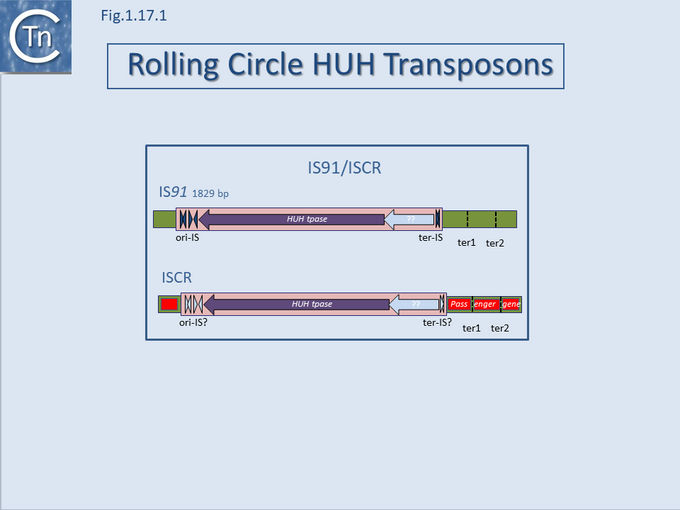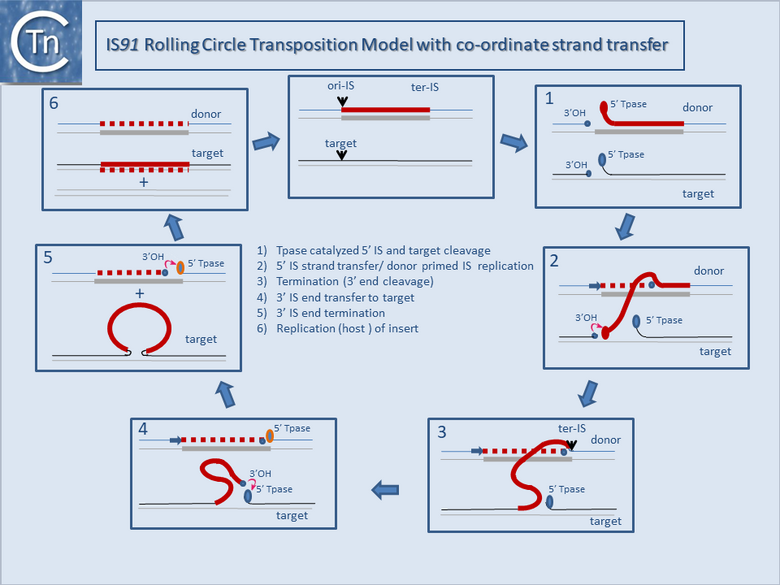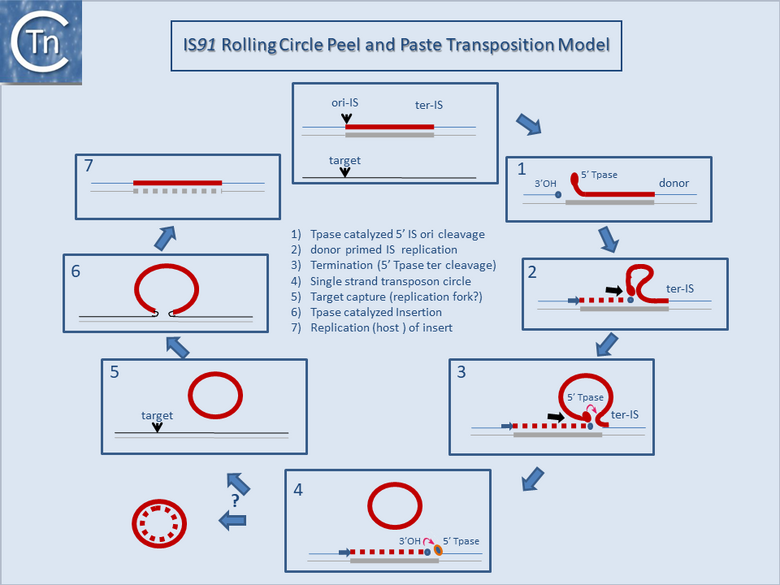Difference between revisions of "General Information/IS91 and ISCR"
| (15 intermediate revisions by the same user not shown) | |||
| Line 1: | Line 1: | ||
| − | [[Image:1.17.1.png|thumb| | + | '''<big>A</big>''' final example of the subtle line dividing IS and transposons is found in the [[IS Families/IS91-ISCR families|IS''91''/IS''CR'' group]] [[:Image:1.17.1.png|(Fig.12.1)]]. [https://tncentral.ncc.unesp.br/ISfinder/scripts/ficheIS.php?name=IS91 IS''91''] was identified some time ago<ref><pubmed>6323920</pubmed></ref> and carries a single Tpase orf. More recently, a group of related elements, IS''CR'' (IS with a "Common Region") was described [reviewed in <ref><pubmed>16760305</pubmed></ref><ref><pubmed>20634542</pubmed></ref><ref><pubmed>16751201</pubmed></ref>] (see the [[IS Families/IS91-ISCR families|IS''91'' and ISCR section]]). [[Image:1.17.1.png|thumb|680x680px|'''Fig.12.1.''' [https://tncentral.ncc.unesp.br/ISfinder/scripts/ficheIS.php?name=IS91 IS''91''] and IS''CR'' families. |
| − | + | The transposons are shown as pink boxes; transposase as purple filled arrows; subterminal secondary structures essential for transposition are shown as filled dark blue ([https://tncentral.ncc.unesp.br/ISfinder/scripts/ficheIS.php?name=IS91 IS''91'']) and pale blue (IS''CR'') arrow-heads. These, known as Ori-IS and ter-IS (in the case of ISCR this has not yet been clearly defined), are involved with initiation and termination of transposition on the rolling circle transposition model; the larger, pale blue arrow is a Y-recombinase gene present in some [https://tncentral.ncc.unesp.br/ISfinder/scripts/ficheIS.php?name=IS91 IS''91''] family elements; secondary places which act as surrogate ends are also indicated to the right in the green flanking DNA; passenger genes are shown as red boxes. |alt=|border|center]] | |
| − | Although there has been no formal demonstration that these actually transpose, the CR is an orf which resembles the IS''91'' family Tpases<ref | + | Although there has been no formal demonstration that these actually transpose, the CR is an orf which resembles the [https://tncentral.ncc.unesp.br/ISfinder/scripts/ficheIS.php?name=IS91 IS''91''] family Tpases<ref><pubmed>23832240</pubmed></ref>. The major feature of [[IS Families/IS91-ISCR families|IS''CR'']] elements is that they are associated with a diverse variety of antibiotic resistance genes and, particularly in the case of ''[[wikipedia:Pseudomonas|Pseudomonas]]'' [[IS Families/IS91-ISCR families|IS''CR'']], aromatic degradation pathways, both upstream and downstream of the Tpase ORF. |
| − | It is thought that these genes are transmitted during the rolling circle type of transposition mechanism postulated to occur in IS''91'' transposition [[:Image:1.17.2.png|(Fig. | + | It is thought that these genes are transmitted during the rolling circle type of transposition mechanism postulated to occur in [https://tncentral.ncc.unesp.br/ISfinder/scripts/ficheIS.php?name=IS91 IS''91''] transposition [[:Image:1.17.2.png|(Fig.12.2)]]. This involves an initiation event at one IS end, polarized transfer of the IS strand into a target molecule, and termination at the second end<ref><pubmed>19709290</pubmed></ref>. However, the [https://web.unican.es/ibbtec/en-us/about-ibbtec/team/members/member-detail?d=Fernando-de-la-Cruz-Calahorra-(IP) de la Cruz lab] has identified circular [https://tncentral.ncc.unesp.br/ISfinder/scripts/ficheIS.php?name=IS91 IS''91''] forms, and it seems possible that these are transposition intermediates. An alternative model involving transposon circle formation is shown in [[:Image:1.17.3.png|Fig.12.3]]. This model is attractive since it would liberate the transposon circle intermediate to locating a target site following circle formation, rather than requiring target engagement during the replicative transposition process [[:Image:1.17.2.png|(Fig.12.2)]]. |
| + | |||
| + | Flanking gene acquisition is thought to occur when the termination mechanism fails and rolling circle transposition extends into neighboring DNA, where it may encounter a second surrogate end <ref>De La Cruz F, Garcillán-Barcia MP, Bernales I, Mendiola MV. IS91 Rolling-Circle Transposition. In: Craig NL, Lambowitz AM, Craigie R, Gellert M, editors. Mobile DNA II. American Society of Microbiology; 2002. p. 891–904. </ref>. This type of mobile element may prove to play an important role in the assembly and transmission of multiple antibiotic resistance<ref><pubmed>21729108</pubmed></ref>. | ||
| − | |||
| − | |||
<center> | <center> | ||
| + | [[Image:1.17.2.png|thumb|780x780px|'''Fig.12.2.''' [https://tncentral.ncc.unesp.br/ISfinder/scripts/ficheIS.php?name=IS91 IS''91''] rolling circle co-ordinated donor-target transposition model: | ||
| + | Rolling circle transposition . The displaced strand of the transposon is in red; the non-displaced strand in grey; newly replicated DNA, dotted red line. '''(1)''' Tpase catalyzed 5' ori-IS cleavage to generate a 3' OH on the donor replicon. Concomitantly, a similar cleavage occurs in the DNA target. '''(2)''' Donor strand (5') displacement into the target site, 3'OH target attack and donor primed IS replication. '''(3)''' Termination (5' Tpase ter cleavage) to generate a 3' OH. '''(4)''' Transposon strand transfer to attack the 5' target site. '''(5)''' strand closure of the donor and target molecules. '''(6)''' Transposon replication in the target. |alt=|border|none]] | ||
| + | [[Image:1.17.3.png|thumb|780x780px|'''Fig.12.3.''' [https://tncentral.ncc.unesp.br/ISfinder/scripts/ficheIS.php?name=IS91 IS''91''] rolling circle Peel and paste transposition model. | ||
| − | + | Rolling circle transposition (adapted from Grabundzija et al., 2016). The displaced strand of the transposon is in red; the non-displaced strand in grey; newly replicated DNA, dotted red line. '''(1)''' Tpase catalyzed 5' ori-IS cleavage to generate a 3'OH on the donor replicon. '''(2)''' Donor primed IS replication. '''(3)''' Termination (5' Tpase ter cleavage). '''(4)''' Single strand transposon circle. '''(5)''' Target capture (replication fork?). '''(6)''' Tpase catalyzed insertion. '''(7)''' Replication (host) of the insert. An alternative possibility is shown in the formation of a double-strand DNA intermediate by replication of the single-strand circle.|alt=|none]] | |
| − | |||
</center> | </center> | ||
==Bibliography== | ==Bibliography== | ||
| − | < | + | {{Reflist|32em}} |
| + | <br /> | ||
| + | <hr> | ||
| + | {{TnPedia}} | ||
Latest revision as of 12:42, 5 December 2022
A final example of the subtle line dividing IS and transposons is found in the IS91/ISCR group (Fig.12.1). IS91 was identified some time ago[1] and carries a single Tpase orf. More recently, a group of related elements, ISCR (IS with a "Common Region") was described [reviewed in [2][3][4]] (see the IS91 and ISCR section).

Although there has been no formal demonstration that these actually transpose, the CR is an orf which resembles the IS91 family Tpases[5]. The major feature of ISCR elements is that they are associated with a diverse variety of antibiotic resistance genes and, particularly in the case of Pseudomonas ISCR, aromatic degradation pathways, both upstream and downstream of the Tpase ORF.
It is thought that these genes are transmitted during the rolling circle type of transposition mechanism postulated to occur in IS91 transposition (Fig.12.2). This involves an initiation event at one IS end, polarized transfer of the IS strand into a target molecule, and termination at the second end[6]. However, the de la Cruz lab has identified circular IS91 forms, and it seems possible that these are transposition intermediates. An alternative model involving transposon circle formation is shown in Fig.12.3. This model is attractive since it would liberate the transposon circle intermediate to locating a target site following circle formation, rather than requiring target engagement during the replicative transposition process (Fig.12.2).
Flanking gene acquisition is thought to occur when the termination mechanism fails and rolling circle transposition extends into neighboring DNA, where it may encounter a second surrogate end [7]. This type of mobile element may prove to play an important role in the assembly and transmission of multiple antibiotic resistance[8].


Bibliography
- ↑ Diaz-Aroca E, de la Cruz F, Zabala JC, Ortiz JM . Characterization of the new insertion sequence IS91 from an alpha-hemolysin plasmid of Escherichia coli. - Mol Gen Genet: 1984, 193(3);493-9 [PubMed:6323920] [DOI]
- ↑
- ↑ Toleman MA, Walsh TR . ISCR elements are key players in IncA/C plasmid evolution. - Antimicrob Agents Chemother: 2010 Aug, 54(8);3534; author reply 3534 [PubMed:20634542] [DOI]
- ↑
- ↑ Chandler M, de la Cruz F, Dyda F, Hickman AB, Moncalian G, Ton-Hoang B . Breaking and joining single-stranded DNA: the HUH endonuclease superfamily. - Nat Rev Microbiol: 2013 Aug, 11(8);525-38 [PubMed:23832240] [DOI]
- ↑ Garcillán-Barcia MP, de la Cruz F . Distribution of IS91 family insertion sequences in bacterial genomes: evolutionary implications. - FEMS Microbiol Ecol: 2002 Nov 1, 42(2);303-13 [PubMed:19709290] [DOI]
- ↑ De La Cruz F, Garcillán-Barcia MP, Bernales I, Mendiola MV. IS91 Rolling-Circle Transposition. In: Craig NL, Lambowitz AM, Craigie R, Gellert M, editors. Mobile DNA II. American Society of Microbiology; 2002. p. 891–904.
- ↑